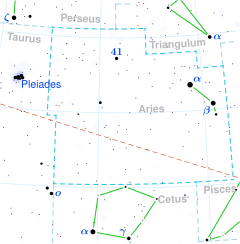Sigma Arietis
| Observation data Epoch J2000.0 Equinox J2000.0 (ICRS) | |
|---|---|
| Constellation | Aries |
| Right ascension | 02h 51m 29.58609s[1] |
| Declination | +15° 04′ 55.4500″[1] |
| Apparent magnitude (V) | +5.52[2] |
| Characteristics | |
| Spectral type | B7 V[3] |
| U−B color index | –0.43[2] |
| B−V color index | –0.09[2] |
| Astrometry | |
| Radial velocity (Rv) | +17.0[4] km/s |
| Proper motion (μ) | RA: +30.13[1] mas/yr Dec.: –23.68[1] mas/yr |
| Parallax (π) | 6.60 ± 0.32 mas[1] |
| Distance | 490 ± 20 ly (152 ± 7 pc) |
| Absolute magnitude (MV) | −0.38[5] |
| Details | |
| Mass | 3.84 ± 0.08[6] M☉ |
| Radius | 3[7] R☉ |
| Luminosity | 301[6] L☉ |
| Temperature | 13,121[6] K |
| Rotational velocity (v sin i) | 165[6] km/s |
| Other designations | |
| Database references | |
| SIMBAD | data |
Sigma Arietis, Latinized from σ Arietis, is the Bayer designation for a star in the northern constellation of Aries. It has an apparent visual magnitude of +5.52,[2] which is bright enough for the star to be seen with the naked eye from dark suburban skies. Based upon an annual measured parallax shift of 6.60 ± 0.32 mas,[1] it is approximately 494 light-years (151 parsecs) distant from the Earth.
Sigma Arietis is a B-type main sequence star with a stellar classification of B7 V.[3] This is a large star with three[7] times the radius of the Sun and 3.8[6] times the Sun's mass. It shines around 301[6] times as brightly as the Sun, with this energy being radiated into space from its outer atmosphere at a scorching hot effective temperature of 13,121 K.[6] It is this heat that gives the star the blue-white hue of a B-type star. Sigma Arietis is spinning at a rapid clip, with a projected rotational velocity of 165 km/s.[6] It is a probable member of the Cas-Tau OB association of stars that share a common motion through space.[9]
References
- ^ a b c d e f van Leeuwen, F. (November 2007), "Validation of the new Hipparcos reduction", Astronomy and Astrophysics, 474 (2): 653–664, arXiv:0708.1752, Bibcode:2007A&A...474..653V, doi:10.1051/0004-6361:20078357.
- ^ a b c d Crawford, D. L.; Barnes, J. V.; Golson, J. C. (1971), "Four-color, H-beta, and UBV photometry for bright B-type stars in the northern hemisphere", The Astronomical Journal, 76: 1058, Bibcode:1971AJ.....76.1058C, doi:10.1086/111220.
- ^ a b Lesh, Janet Rountree (December 1968), "The Kinematics of the Gould Belt: an Expanding Group?", Astrophysical Journal Supplement, 17: 371, Bibcode:1968ApJS...17..371L, doi:10.1086/190179.
- ^ Wielen, R.; et al. (1999), Sixth Catalogue of Fundamental Stars (FK6). Part I. Basic fundamental stars with direct solutions, Astronomisches Rechen-Institut Heidelberg, Bibcode:1999VeARI..35....1W.
- ^ Anderson, E.; Francis, Ch. (2012), "XHIP: An extended hipparcos compilation", Astronomy Letters, 38 (5): 331, arXiv:1108.4971, Bibcode:2012AstL...38..331A, doi:10.1134/S1063773712050015.
- ^ a b c d e f g h Zorec, J.; Royer, F. (January 2012), "Rotational velocities of A-type stars. IV. Evolution of rotational velocities", Astronomy & Astrophysics, 537: A120, arXiv:1201.2052, Bibcode:2012A&A...537A.120Z, doi:10.1051/0004-6361/201117691.
- ^ a b Pasinetti Fracassini, L. E.; et al. (February 2001), "Catalogue of Apparent Diameters and Absolute Radii of Stars (CADARS) - Third edition - Comments and statistics", Astronomy and Astrophysics, 367: 5211–524, arXiv:astro-ph/0012289, Bibcode:2001A&A...367..521P, doi:10.1051/0004-6361:20000451
- ^ "sig Ari". SIMBAD. Centre de données astronomiques de Strasbourg. Retrieved 2012-07-18.
{{cite web}}: CS1 maint: postscript (link) - ^ de Zeeuw, P. T.; et al. (January 1999), "A HIPPARCOS Census of the Nearby OB Associations", The Astronomical Journal, 117 (1): 354–399, arXiv:astro-ph/9809227, Bibcode:1999AJ....117..354D, doi:10.1086/300682.

